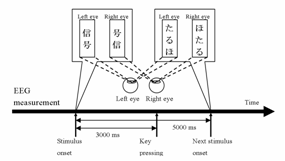 |
Fig. 1 Stimulus presentation interval and EEG measurement |
 |
Fig. 2 ECD localized to the left fusiform gyrus at 841 ms (subject: NS), Kanji |
 |
Fig. 3 ECD localized to the left angular gyrus at 761 ms (subject: NS), Kana |
| Ref: T. Yamanoi et. al. : Dominance of recognition of words presented on right or left eye -Comparison of Kanji and Hiragana-, Modern Information Processing, From Theory to Applications, B. Bouchon-Meunier, G. Coletti and R.R. Yager Eds., Elsevier Science B.V., pp. 407-416, 2006 |